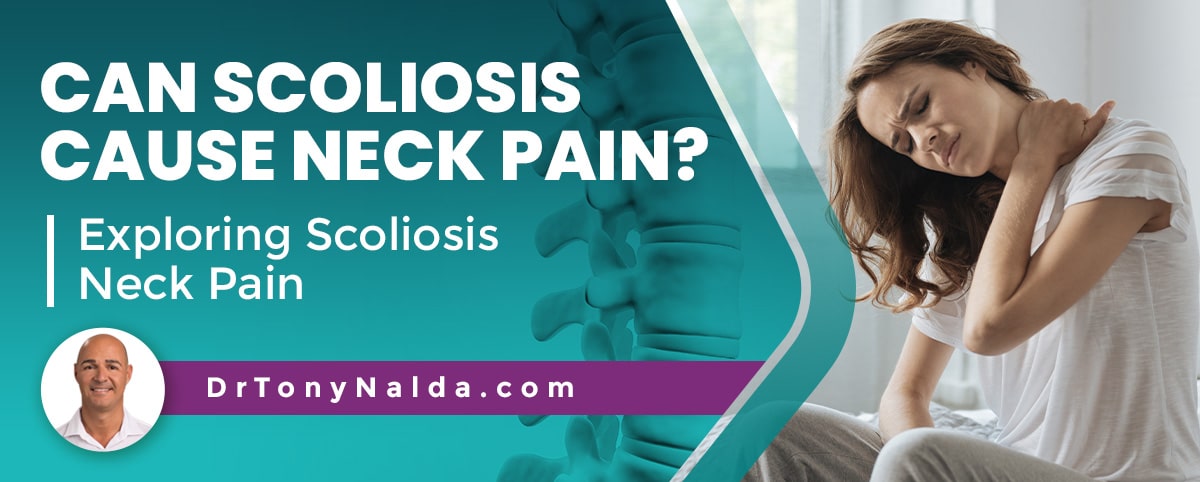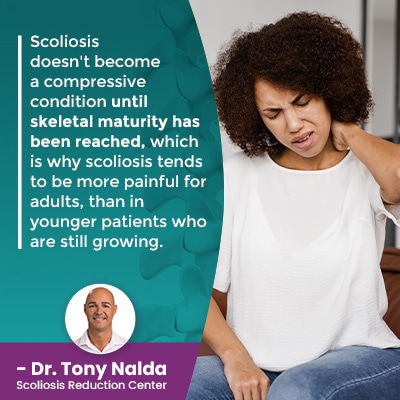Can Scoliosis Cause Neck Pain? Exploring Scoliosis Neck Pain

As scoliosis introduces a lot of uneven forces to the body, its effects can be felt throughout. Although the condition isn't commonly painful for younger patients, back and neck pain are common symptoms of adult scoliosis. Neck pain is associated with a loss of motion in the cervical spine, and particularly when scoliosis develops in the neck, muscle pain is a common symptom.
As an unnatural sideways spinal curve, scoliosis can develop in any spinal section, from the neck to the lower back. As scoliosis progresses, it causes a loss in spinal flexibility and range of motion, and when the cervical spine is involved, head positioning can be affected, causing related neck pain.
Before moving on to the specifics of scoliosis neck pain, let's first explore some important condition features, for a better understanding of how the condition affects the body.
Table of Contents
Being Diagnosed with Scoliosis
Being diagnosed with scoliosis means an unnatural sideways spinal curve, with rotation, has developed, and it's the rotational component that makes scoliosis a 3-dimensional condition, as the spine doesn't just bend unnaturally to the side, but also twists from front to back, back to front.
As the brain and spinal cord work in tandem to form the body's central nervous system, the spine is involved in virtually every working system within the body, which is why its effects can be felt throughout.
In addition, a scoliotic curve has to be of a minimum size to be diagnosed as a true scoliosis: minimum Cobb angle of 10 degrees.
A patient's Cobb angle is a measurement taken during X-ray that tells me how far out of alignment a scoliotic spine is, and the higher the Cobb angle, the more severe the condition:
- Mild scoliosis: Cobb angle measurement of between 10 and 25 degrees
- Moderate scoliosis: Cobb angle measurement of between 25 and 40 degrees
- Severe scoliosis: Cobb angle measurement of 40+ degrees
- Very-severe scoliosis: Cobb angle measurement of 80+ degrees
As you can see from the wide range of Cobb angle measurements, scoliosis is a highly-variable condition, meaning symptoms one patient experiences aren't necessarily indicative of what others will face.
It's also important for patients to understand that where a scoliosis is at the time of diagnosis is not indicative of where it will stay..
Scoliosis is Progressive
Scoliosis is a progressive condition, meaning it has it in its very nature to worsen over time, particularly if left untreated, or not treated proactively.
Even scoliosis that's mild at the time of diagnosis can easily progress to become moderate, severe, or very severe; only proactive treatment can counteract the condition's progressive nature.
When scoliosis is progressing, this means the unnatural spinal curve is increasing in size, the condition's symptoms are likely escalating and becoming more noticeable, and particularly in cases of adult idiopathic scoliosis, the condition can become more painful.
The main trigger for progression is growth and development, which is why in the condition's most-prevalent type, adolescent idiopathic scoliosis, diagnosed between the ages of 10 and 18, these scoliosis patients are at risk for rapid-phase progression.
One of the most important indicators of whether or not a patient's scoliosis is going to be painful is patient age, and this is related to compression.
Scoliosis and Compression
When it comes to scoliosis pain, whether or not a condition is compressive is an important factor.
 Scoliosis doesn't become a compressive condition until skeletal maturity has been reached, which is why scoliosis tends to be more painful for adults, than in younger patients who are still growing.
Scoliosis doesn't become a compressive condition until skeletal maturity has been reached, which is why scoliosis tends to be more painful for adults, than in younger patients who are still growing.
Growing spines are experiencing a constant lengthening motion, and this counteracts the compressive force (uneven pressure) of the unnatural spinal curve, and it's compression of the spine and its surrounding muscles and nerves that causes the majority of condition-related pain.
Scoliosis pain can range from mild and intermittent to chronic pain that's debilitating and benefits from pain medication, and of course, there are patients for whom the condition isn't painful at all.
Scoliosis and Neck Pain
As mentioned, when it comes to scoliosis neck pain, due to compression, it's more likely to be an issue for adults than adolescents, but each case is unique and shaped by key patient/condition variables: patient age, condition severity, type, and curvature location.
While children and adolescents aren't vulnerable to compression, it should be mentioned that approximately 20 percent of adolescent idiopathic scoliosis patients report issues with back and/or muscle tension and pain.
Remember, it's not just up to the spine to maintain its natural curves and alignment, but also its surrounding muscles that help support and stabilize the spine.
The condition's uneven forces apply pressure to the spine and its surrounding muscles and nerves, and in cases of scoliosis causing postural changes that disrupt the body's overall symmetry, the body's muscles are having to work harder to try and counteract the uneven forces, often becoming strained and unbalanced.
Particularly when scoliosis develops in the cervical spine, and particularly in older patients for whom the condition is compressive, mild to chronic neck pain can become an issue, and as scoliosis progresses, spinal rigidity in the neck will worsen.
A stiff neck means a loss in spinal flexibility, and this tends to result in a reduced range of motion in the area, and as the vertebrae of the cervical spine are losing their ability to move effectively, these vertebral subluxations can become more and more problematic.
Postural deviation can increase structural issues and pain, although more common in adults, and military neck is an excellent example of this.
Military Neck
Also referred to as cervical kyphosis, military neck involves the development of an excessively-straight neck as the cervical spine's natural kyphosis (forward curve) is lost.
 If scoliosis has affected the cervical spine, causing disc degeneration, postural changes, or other structural issues, military neck is a common complication.
If scoliosis has affected the cervical spine, causing disc degeneration, postural changes, or other structural issues, military neck is a common complication.
People with military neck have an unusually-straight neck, giving the appearance of standing at attention, hence its name.
As military neck develops, there is a forward shift in posture, known to cause forward head posture, which increases the weight of the head on the neck and spine significantly, and this introduces adverse spinal tension and can disrupt the entire spine's biomechanics and function.
In addition, the muscles that support the cervical spine are strained as they try to support the increasing weight of the head due to the postural shift caused by the unnatural spinal curve in the neck, and this can cause neck pain and a variety of neck problems.
If left untreated, military neck and forward head posture can cause a number of spinal issues and symptoms:
- A stiff neck
- Decreased range of motion
- Coordination issues
- Coordination issues
- Neck pain
- Radicular pain felt in the fingers and toes
- Muscle weakness
- Postural deviation
- Headaches
While not every patient with scoliosis of the cervical spine will develop military neck and forward head posture, it is a common complication, and if left untreated, can lead to disc degeneration (spine's shock absorbers), lumbar spine and thoracic spine issues (compensatory curves), back pain, muscle tension, and make the spine vulnerable to a number of spinal disorders.
In addition to pain in the neck caused by the development of an abnormal spinal curvature and related muscle strain and imbalance, scoliosis is also known to cause chronic headaches that can reach migraine status.
Scoliosis and Headaches
Scoliosis patients experiencing neck pain are also prone to tension headaches and potential migraines.
When the neck muscles become tight and stiff due to a reduced range of motion in the cervical spine, the head is exposed to adverse tension, and this can cause headaches ranging from mild to severe.
Scoliosis is also associated with disruptions to the flow of cerebrospinal fluid (CSF) that passes through the spinal canal.
CSF provides cushioning in and around the brain and spinal cord, in addition to delivering nutrients needed, so any disruption to the flow of CSF in and around the brain can cause headaches that range in severity.
Conclusion
So to clearly answer the question, can scoliosis cause neck pain: yes, it can, but isn't guaranteed to do so.
Each case of scoliosis is unique, which is why the condition's complex nature necessitates the customization of effective treatment plans.
An abnormal spinal curvature located closest to the neck (cervical and thoracic spine) is more likely to cause pain in the neck than lumbar scoliosis.
However, as the health of each spinal curve is dependent on the health of the others, even an abnormal lumbar curve can affect the neck if a compensatory curve is put in an attempt to counteract the unnatural curvature of the lower back.
In addition, scoliosis can also cause neck-muscle pain and can lead to a disruption in the flow of cerebrospinal fluid, also known to cause neck pain and headaches.
Chronic poor posture and or postural changes caused by scoliosis can lead to conditions known as military neck and forward head posture, which can lead to a reduced range of motion, and strained muscles as a result.
Scoliosis neck pain is most closely associated with a loss of motion in the cervical spine, so part of my scoliosis treatment involves physical therapy and chiropractic care so muscles are strengthened and balanced, while the spine is impacted on a structural level.
By combining different treatment options, I can assess the patient's range of motion loss in the neck, determine its underlying cause, and shape a customized treatment plan around restoring that loss of motion so adverse tension on the spine, its surrounding muscles, and nerves is reduced.
Here at the Scoliosis Reduction Center, I work towards addressing all scoliosis symptoms, neck pain included, by impacting its underlying cause: the condition's underlying structural nature.
Dr. Tony Nalda
DOCTOR OF CHIROPRACTIC
After receiving an undergraduate degree in psychology and his Doctorate of Chiropractic from Life University, Dr. Nalda settled in Celebration, Florida and proceeded to build one of Central Florida’s most successful chiropractic clinics.
His experience with patients suffering from scoliosis, and the confusion and frustration they faced, led him to seek a specialty in scoliosis care. In 2006 he completed his Intensive Care Certification from CLEAR Institute, a leading scoliosis educational and certification center.
About Dr. Tony Nalda
 Ready to explore scoliosis treatment? Contact Us Now
Ready to explore scoliosis treatment? Contact Us Now





